Alerts Page
Opsgenie alerts page is the list page for all alerts that are visible or assigned to a user. Apply filters, or execute bulk actions (close multiple alerts, ack all etc.), on the alerts page.
Clicking on an alert's message opens the details window for that alert. The user is considered as "has seen the alert", and the alert notifications for that user will stop.

A: New Alert and Incident page separation, designate which view by clicking on the coordinating tabs
B: Bulk actions
C: Query field
D: Alert message
E: Alert tags
F: Responder Teams
G: Alert priority (indicated by color) and deduplication count
H: Alerts status (Open, Ack'd, Closed)
Alert filtering is async, changes to alerts by other users or systems available to list page at most within 2 seconds.
Alert actions and the details page are real time, async behaviour have minor impact on user experience.
Alert List View Options
In addition to viewing Alerts in a standard list view, there are different views accessible by the settings icon on the right side of the list header.
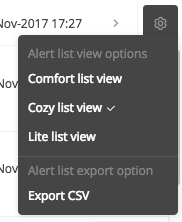
Searching Alerts Within Opsgenie (Video)
Saved Searches
There are quick built-in searches for easy use in the left sidebar alerts page. These and what they filter are explained below:
All: This shows all the alerts, including open, acked, and also closed alerts.
Open: This is the default view filter. This shows the alerts that are open or alerts that are acknowledged but not yet closed.
Closed: Selecting this shows only closed alerts.
Unack'ed: This shows only the alerts that are open and not yet acknowledged by anyone.
Not Seen: This shows the alerts that are open and no user has viewed or listened to their details yet.
Alerts: This shows only alerts, regardless of their status.
Incidents: This shows only Incidents, regardless of their status.
Mass Notifications: This shows only Mass Notifications.
Mass notification feature is only available for old plan customers who subscribed to Opsgenie before November 2, 2018.
Easy Searching
When a tag of an alert on the alerts page is clicked, it applies a filter to list the alerts that have that tag. This easy filtering is also performed by clicking on the recipients of an alert, the owner of an alert, or the teams of an alert.
Custom Saved Searches
Click on the "Save" button on the top-right of the query bar to save a search that's based on alert attributes. This includes listing alerts with a particular tag, or alerts assigned to a specific team, etc. Clicking on the "Search" button applies the filter and reload the alerts list. Add multiple tags by searching them separated by a space.

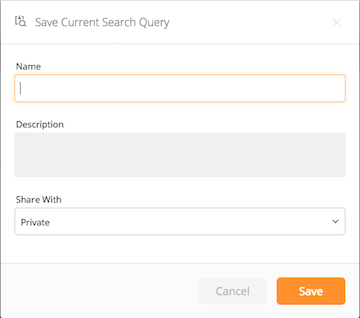
Saving a SearchWhen "Save" is clicked from the search query bar, the above dialogue box appears to enter a name for the Search, add a description, and sharing privileges. Once "Save" is clicked, it will appear in the "Saved Searches" left sidebar under "Created by me".
Visibility of Alerts
Owners and admin users can see all alerts in the alerts page. Users can only see the alerts assigned to them; plus the alerts that their teams are added to.
Owners and admin users can use "See all alerts" toggle to view all alerts or the alerts assigned to them and teams they're a part of.

Alert Details
Clicking on an alert will open the details window for that alert.

Alert details window contains the following:
- Alert properties: Alert message, Tiny ID, Source, Status, etc
- Add Tags (+): Add new tags to the alert by clicking the "+" under the alert name and typing the tag name
- Remove Tags ([tag name]x): Remove tags from the alert by clicking the "x" on the tag listed
- Count: The count of the alert, meaning how many times a create request has been received with the same alias. See Alert De-Duplication for details
- Alert recipients: Each recipient user is listed and their actions on the alert are shown
- Actions: Execute the custom and built-in actions on the alert
Notes and AttachmentsNotes and Attachments can now be added and accessed by expanding the collapsable side menu (shown below).

Collaborators add notes to keep each other up to date on the alert by clicking the notepad icon, typing the note, and clicking "Add note". The notes will be added to the list with the contributor's name and time added.
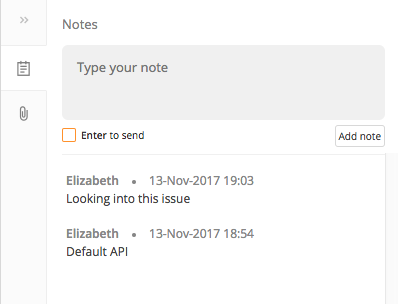
Attachments are added by clicking on the paper clip icon then the "Add new" button to upload a new file.
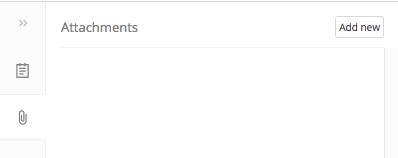
Alert Activity Log
Logs of each alert are displayed in the "Activity Log" tab of the details window. Activity logs are very useful to determine:
- which user or integration created the alert,
- the notifications that were sent for the alert,
- updates to the alert, e.g who acknowledged/closed the alert, which notes were added etc.
- which policies were run in the creation of the alert,
- possible errors that were encountered in the alert life cycle

Actions
Select and execute many actions on an alert on the Alerts page by selecting the desired action from the drop down menu.
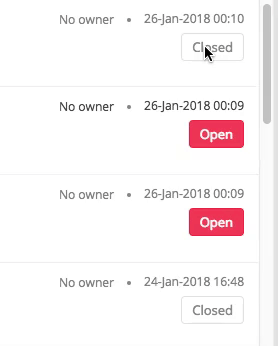
Bulk Actions
On the alerts page, select one or multiple alerts for bulk actions to be taken. This includes all available actions from the details page of an alert, aside from executing custom alert actions. The advantage of the alerts page is the ability to execute these actions on multiple alerts. It is possible, for example, to select multiple alerts and acknowledge or close them all with a single button.

Similarly, the options to "Ack all" and "Close all" are accessible via the left sidebar.

Ack All
"Ack All" button acknowledges all alerts with a single action. Upon clicking and confirming the prompt, Opsgenie starts an asynchronous process that assigns ownership of every open alert to the user completing the action.
Close All
"Close All" button closes all alerts with a single action. Upon clicking and confirming the prompt, Opsgenie starts an asynchronous process that closes every open alert.
Updated 7 months ago
